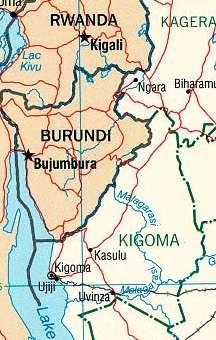Kigoma Region
| Kigoma Region Mkoa wa Kigoma (Swahili) | |
|---|---|
| Region | |
|
Lake Tanganyika shore | |
 Location in Tanzania | |
| Country | Tanzania |
| Zone | Central |
| Capital | Kigoma |
| Government | |
| • Regional Commissioner | Issa Machibya |
| Area | |
| • Total | 37,040 km2 (14,300 sq mi) |
| Population (2012) | |
| • Total | 2,127,930 |
| • Density | 57/km2 (150/sq mi) |
| Time zone | EAT (UTC+3) |
| Postcode | 47xxx |
| Area code(s) | 028 |
| Website |
kigoma |
Kigoma Region is one of Tanzania's 30 administrative regions. The regional capital is the city of Kigoma. According to the 2012 national census, the region had a population of 2,127,930, which was higher than the pre-census projection of 1,971,332.[1]:page 2 For 2002-2012, the region's 2.4 percent average annual population growth rate was tied for the fourteenth highest in the country.[1]:page 4 It was also the sixteenth most densely populated region with 57 people per square kilometer.[1]:page 6 With a size of 45,066 square kilometres (17,400 sq mi),[2] the region is slightly smaller than Estonia (45,227 square kilometres (17,462 sq mi)).
Geography

Kigoma Region resides in the northwestern corner of Tanzania, on the eastern shore of Lake Tanganyika. The region lies at about 5° south and 30° east of Greenwich. The region is bordered to the north by both Burundi and the Kagera Region. To the east, it is bordered by the Shinyanga and Tabora regions, to the south by the Rukwa Region, and to the west by Lake Tanganyika, which forms a border with the Democratic Republic of the Congo.[3]
The region's total area is 45,066 square kilometres (17,400 sq mi),[4] of which 37,037 square kilometres (14,300 sq mi) is land and 8,029 square kilometres (3,100 sq mi) is water.[3] The region's total area is just 161 square kilometres (62 sq mi) less than that of Estonia. As of 1998, approximately 20,000 square kilometres was in forests and 12,000 square kilometres was suitable for grazing or farming.[3]
Kigoma Region is on a plateau that slopes from the northeast at about 1,750 meters down to 800 meters at the shore of lake Tanganyika.[5] The topography in the north and east is gently rolling hills that gradually become steeper as they get closer to the Albertine Rift margin.[5] The most important river is the Malagarasi, with the Luiche and the Ruchugi being the two other major rivers draining the region.[5]
History
.png)
In precolonial Africa the region was a source of ivory and slaves.[6] Tabora and Ujiji were Arab staging areas for shipments to the coast.[7] It was visited by the early European explorers Richard Burton, John Speke, David Livingstone, and Henry Morton Stanley. In fact, Stanley met Livingstone in Ujiji on the shores of Lake Tanganyika on 27 October 1871.[8] In colonial times, the Kigoma area was known as the Western Region and the capital was Tabora.[6]
Districts
The region is administratively divided into eight districts:[1]
| Districts of Kigoma Region | ||||||
|---|---|---|---|---|---|---|
| Map | District | Population (2012) | ||||
 |
Buhigwe | 254,342 | ||||
| Kakonko | 167,555 | |||||
| Kasulu Rural | 425,794 | |||||
| Kasulu Urban | 208,244 | |||||
| Kibondo | 261,331 | |||||
| Kigoma Rural | 211,566 | |||||
| Kigoma Urban | 215,458 | |||||
| Uvinza | 383,640 | |||||
| Total | 2,127,930 | |||||
References
- 1 2 3 4 Population Distribution by Administrative Units, United Republic of Tanzania, 2013
- ↑ Statistical Abstract 2011, Tanzania National Bureau of Statistics
- 1 2 3 Planning Commission, Dar es Salaam, and the Regional Commissioner's Office, Kigoma (December 1998). "Kigoma region: Socio-Economic Profile" (PDF). United Republic of Tanzania. p. 1. Archived (PDF) from the original on 30 May 2004.
- ↑ National Sample Census of Agriculture 2002/03: Volume Vq: Regional Report: Kagera Region, Tanzania National Bureau of Statistics, December 2007, page 1
- 1 2 3 Planning 1998, p. 2
- 1 2 Head of Regional Office, Kigoma (2011), "2.0 Historia Fupi ya Mkoa (Short History of the Region)", Taarifa ya Miaka 50 ya Uhuru wa Tanzania Mkoa wa Kigoma (Information concerning 50 Years of the Independence of Tanzania: Kigoma) (PDF) (in Swahili), Office of Prime Minister, pp. 4–7
- ↑ Dugard, Martin (2004). Into Africa: The Epic Adventures of Stanley and Livingstone. New York: Broadway Books. p. 68. ISBN 978-0-7679-1074-3. [not the first edition]
- ↑ Dugard 2004, p. 266
Coordinates: 5°00′S 30°00′E / 5.000°S 30.000°E
